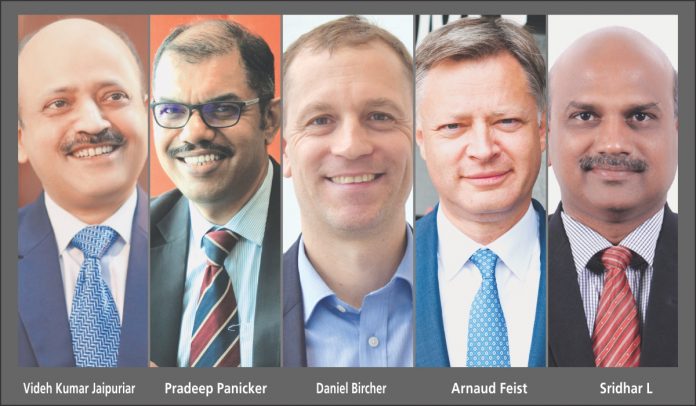For achieving sustainable transformation goals, global airports need to adopt concrete green transport, architecture plans, implement hybrid model, utilise green and non-green resources in order to facilitate smooth business operations in line with United Nations Sustainable Development Goals.
Ritika Arora Bhola
COVID-19 has proved to be a blessing in disguise for the global air cargo sector as it accelerated the need for sustainability to achieve growth. The ongoing pandemic has made stakeholders realize the need to preserve the environment to eliminate, minimize, or compensate for environment and the industry’s commitment to reduce its environmental footprint through decarbonization and waste reduction programs. In the last few years, airports worldwide, in line with the UN Sustainable Development Goals 2030, have taken various groundbreaking initiatives.
Delhi International Airport Limited (DIAL) is all set to become a Net Zero Carbon Emission Airport by 2030, well ahead of the IPCC’s 2050 target adopted by all industries across the world. Videh Kumar Jaipuriar, CEO, DIAL, says, “DIAL’s sustainability framework is focused on creating economic value, delivering service excellence, caring for the environment, and improving quality of life. It follows the UN’s SDG 2030 goals, ICAO’s environmental objectives, and other relevant initiatives to transform into a sustainable and environment-friendly business.”
Jaipuriar outlines a few initiatives taken in the last two-three years:
- DIAL has embraced the Airport Carbon Accreditation framework for airports to manage and reduce carbon emissions.
- In 2016, DIAL became the first airport in the Asia Pacific to achieve ACI “Level 3+”, in 2020, the accreditation was upgraded to “Level 4+” as the first airport in the Asia Pacific and second globally.
- DIAL uses Taxibots and an Airport Collaborative Decision Making (A-CDM) system. Taxibots have led to a reduction of 1154 T CO2.
- It operates a 16-km-long fuel hydrant network and installed bridge-mounted equipment in 78 aerobridges of T3, which reduces emissions from the aircraft’s Auxiliary Power Unit.
- DIAL has adopted energy management system and is certified for ISO 50001:2018.
- DIAL has signed a long-term PPA with a hydropower plant for developing 9 ml of rainwater storage facilities as a part of sustainable water development program.
- Both cargo terminals have rooftop solar PV plants. The capacity of these plants is 4.52 mw, which meets the overall power consumption of the terminals. Implementation of an efficient lighting system is a focus area of the terminals.
- Pradeep Panicker, CEO, GMR Hyderabad International Airport Limited (GHIAL), says, “The airport considers environmental protection and sustainability as an integral part of the business operations and is committed to operating in an environment-friendly and sustainable manner.”
- He highlights green initiatives at the cargo terminal operated by the GMR Hyderabad Air Cargo (GHAC):
- GHAC works towards eliminating fossil-fuel-powered material handling equipment.
- The use of novel ‘slip-sheets’ in cargo handling instead of wooden or plastic skids leads to a reduction in demand for wood, lighter loads, reduced fuel burn on-board aircraft, and reduced wastage/pollution from used skids (wood/plastic). To enable this, GHAC has invested in specialized equipment and training in collaboration with both shippers and airlines.
- Modern IT systems minimize the need for paper-based processing in operations.
- Terminal lighting is being changed to energy-efficient and LED units, thereby reducing the power consumed.
- World-class handling procedures are designed to ensure safe handling of dangerous/toxic goods with no damage or discharge to the environment.
In addition, Panicker affirms that GHAC operations benefit from ACI Level 3+ (carbon neutral status) supported by a 10 MW captive solar power plant, rainwater harvesting in the airport campus, including cargo facilities for up to 90 days without external supply and water treatment/re-use ensuring nil discharge to the environment.
Daniel Bircher, CMD, Noida International Airport (NIA) says, “Sustainable business operations are crucial as Zurich Airport has set the vision for NIA to become India’s first ‘Net-Zero-Emission’ airport operator. We are developing four sub-concepts (energy, fuel, waste, and water) and developing feasible solutions. The aim is to strengthen all-inclusive, green, and sustainable growth of air transportation in India. NIA is planning initiatives in areas aligned with UN’s SDGs 2030. As a part of NIA’s approach toward sustainability, applicable SDGs are being evaluated and initiatives are being planned.”
Arnaud Feist, CEO, Brussels Airport Company also lists down some of the green initiatives:
- Brucargo West: It is a logistics building suitable for handling of pharmaceuticals (vaccines). It also has sustainable infrastructure with LED lighting and heat pumps. The roof is designed so as to be fitted with solar panels in the future.
- Bicycle Bridge Brucargo: Investment supported by Flanders and the European Union to promote soft mobility and evolve towards a true intermodal hub.
- Digital Green Lane: Digitization of the cargo processes at the Brussels Airport, Air Cargo Belgium and Brucargo community leverages BRUcloud. The standarised pick-up and delivery process is efficient and paperless.
- Stargate EU Green Deal: The commitment of a consortium of 22 partners, led by Brussels Airport, to take up airport operations in a greener way.
- The Air Cargo Complex, Mumbai installed solar panels capable of generating 1720.16 kv. They are currently operational.
- Diesel-operated cargo handling equipment such as forklifts, tugs, and tractors are being replaced with battery-operated equipment and vehicles in a phased manner.
- To keep carbon and noise emissions below regulated levels, period checks are also conducted.
- Non-conventional electrical fittings have been replaced with LED lights, and processes were digitized to facilitate paperless transactions.
- To reduce the dwell time, CSMIA has launched the D cube delivery system to facilitate paperless/contactless transactions for import operations.
- GHIAL has been reducing carbon emission by using solar power and reducing power consumption. The airport operates on solar-based ground support such as baggage freight loader and stepladder. The airport is working towards a zero-emission GSE and GSV replacing conventional vehicles with EVs in line with Ministry of Civil Aviation guidelines.
- During the current expansion, the PTB-LEED silver rating is being upgraded to Gold by enhancing the energy, water-efficient and waste management features. The US GBC has accorded in-principal approval to the PTB’s design.
- GHIAL has developed a green belt, apart from existing natural greenery. The green cover acts as a GHG sink and absorbs 695 tonnes of CO2 per year.
- BIAL uses plastic waste to lay roads within the campus.
- After a road trial utilising plastic and bitumen, the airport constructed polymerised roads with a binding ability and can withstand all weather conditions.
- We have undertaken various landscaping, afforestation drives, provisioned several e-charging pods, and emission control mechanisms to achieve sustainability goals.
- BIAL is part of ACA initiative, launched by Airports Council International, a global benchmark for airports.
- BLR Airport has retained Carbon Accreditation Level 3+ from ACI, and is upgrading its ACI accreditation to Level 4+ by FY 2022-23. Approximately 950 CFL lights have been replaced with LED lights.
- We are applying Green Building concepts in our upcoming terminal in line with world-class standards.
- Another step BIAL plans to roll out is electric bus shuttle ops between T1 and T2.
Feist adds, “Until 2026, 30 projects will be tested, and if proven successful, they will be rolled out. These projects include electrification, fuelling of taxiing, ground handling equipment, production, and promoting Sustainable Aviation Fuel (SAF) through an on-site blending installation to increase the use of renewable energy. The project plans to realize a fully digital green lane by creating a new application linked to BRUcloud, including digitizing airside processes by increasing efficiencies (reducing CO2 emissions).”
The upcoming Greenfield Mopa International Airport in Goa has taken up environmental and sustainability initiatives. “The airport is being developed to become a zero-carbon airport by the fifth year of its operation. Its terminal building is being developed as a Green Building, as per IGBC standard, and received a platinum rating during pre-certification. The airport, which has an HVAC system and energy-efficient lighting, will have five MW solar plant. It also plans to use electric vehicles (EVs) for transportation,” said the spokesperson.
Sridhar. L, Head, Sustainability, Bangalore International Airport Limited (BIAL) says, “We have tied-up with the stakeholders to address environmental sustainability, economic stability, and social responsibility. The entire campus is now water positive and become energy neutral. We have strived to restore the past glory of ‘Devanahalli’ pomello, a citric fruit of the region. We also deployed smart automatic irrigation system to manage the landscape on our campus. Rooftop solar panels and an off-site PPA were initiated for wind and solar energy.”
“We are also driving paper consumption reduction across our operations by adopting digital processes. BLR Airport saved 2.2 million units of energy in 2020-2021, which was enough to supply electricity to 9,000 houses in a month. As a result, the airport reduced 50,000 tonnes of carbon emissions. In the future, we intend to adopt an aggressive approach to accomplish Net Zero Carbon Emissions by 2030,” says Sridhar.
Since its inception, Chhatrapati Shivaji Maharaj International Airport has practised environment-friendly processes across all its terminals, as per an official spokesperson.
Airport’s Green Plan
In the last few years, the airports worldwide have formulated concrete green plans to achieve net zero emissions target by 2030. With efficient, green transport, architecture plans, and best practices in place, using a wide range of renewable energy resources and energy efficiency technology to minimize air cargo impact on the environment—the industry promises a bright future for the planet.
Acknowledging the same, Jaipuriar highlights DIAL’s components of a net-zero roadmap:
Green transport plan: DIAL has adopted electric bus services for passenger movement. It is in the process of replacing its existing fleet by using the EVs in a phased manner.
Green architecture plan: DIAL has adopted a green infrastructure program at IGIA. The adoption of the green building principle resulted in receiving the leadership in energy and environmental design (LEED), Gold level for T3 under the new çonstruction’ category in 2011. The Terminal3 has received Platinum level in performance excellence in electricity renewal certification system from the US Green Building Council. Currently, the Terminal1 is being developed as a LEED-compliant building.
Renewable energy: DIAL also installed a 7.84 mw solar plant in the premises. It also has a solar plant in the airside area.
Energy efficiency: The IGIA has adopted ISO 50001 for effective energy management.
Panicker shares few green initiatives adopted by GHIAL:
“The airport has been sustaining its status by augmenting the carbon emission reduction used by optimization of air conditioning system; electricity consumption reduction by LEDs, and other energy-efficient practices; single engine aircraft taxing resulted in 4,382 kl of ATF savings and use of fixed electrical ground power resulted in prevention of APU usage, leading to saving to ATF consumption of 34,622 litres per year. The airport is equipped with gaseous and particulate matter analyzers to provide real-time air quality 24×7,” adds Panicker.
Meanwhile, Bircher says the NIA has adopted some practices to minimize environment impact on its operations.
Sustainable Greenfield Airport
“We are planning to develop the airport considering requirements of green infrastructure such as green buildings and campus. Green and sustainable initiatives such as usage of EVs airside, RWH, tree conservation and transplantation, STP, waste management facility are planned. These initiatives will be reviewed through environment management system. This will make NIA a green and sustainable airport and also set the benchmark to other Greenfield airports in the region,” says Bircher.
Renewable Energy
Continuing, Bircher says, “We have planned to use the renewable energy from in house solar farm to generate enough green energy for the airport operations. We have incorporated elements of energy-efficient infrastructure such as EMS, LED lighting, efficient chillers, and use of natural lights in the airport design.”
Airside traffic management
“We believe aviation operations can be improved by cutting emissions and reducing the time taxiing time. This could be achieved by optimizing the design of runways, taxiways, and terminals, improving air traffic and navigation management systems. At NIA, our endeavour is to achieve short turnaround time and low operating costs for airlines, cargo/logistics providers by supporting them in optimizing fleet utilization and fuelling domestic and global growth. We will offer flexible, modular, cost-effective cargo and logistics infrastructure along with intermodal connectivity to and from manufacturing hubs,” asserts Bircher.
For BIAL, Sridhar says, “Our roadmap 2030 is built on six pillars—water stewardship, net zero carbon emission, community aligned noise management, circular economy, sustainable procurement, and sustainable mobility. We aim to achieve green and clean solutions to balance our current and future needs. We will work to reduce carbon emission through usage of renewable electricity.”
He lists down some of the green plan initiatives:
Supporting airports’ green ops
Building eco-friendly airports with a stable infrastructure and renewable energy sources is key to achieving sustainability in the industry. India is at the forefront of green infrastructure and GMR airports are taking the lead in developing it in airports.
Jaipuriar says, “Natural resource conservation is key in operational strategies adopted by GMR Group. Energy and water efficiency, and use of renewable energy are key aspects of GMR Group’s green vision. GMR airports are focusing on implementing green transportation by replacing the existing fleet with EVs in a phased-wise manner. Another area is to make cargo ops digitized. DIAL facilitates paperless and contactless operation in export and import cargo operations.”
However, Panicker feels, “The green infrastructure in India related to logistics is evolving and needs a lot to be done in areas such as green mobility, sustainable packaging, paperless processing, and renewable energy usage to drive the industry towards the goal of zero carbon era.”
On the other hand, Bircher says, “There is scope to increase green infrastructure in India to achieve net-zero emissions by 2070. The airports can apply to reduce its carbon footprint that are under their direct control. These include improvements in energy efficiency and conservation, ground fleet conversions, low emission power generation plants in-site, or renewable energy supplies. The NIA has incorporated the requirements of IGBC Green Building certification in the design. It will have an efficient terminal design with lighting system allowing natural sunlight as a source of illumination at different hours of the day.”
Aiming to become net zero carbon by 2050, Feist says, “We are pushing for electrification of existing heating systems at Brussels Airport. New energy-efficient buildings/warehouses will be constructed with gas-free heating system. New buildings will be heated by heat pumps, wherever possible supported by geothermal energy. BAC is addressing the need for green energy supply by looking into installing additional solar panels to ensure 100 per cent green energy supply.”
Green airports to boost economy
Looking at the market scenario, it is not feasible to operate solely on biofuel or renewable sources of energy alone. At present, it is better to have a hybrid model—a blend of green and non-green resources and infrastructure for improving sustainability. Jaipuriar agrees, “An off the grid Green Airport will be a good concept to provide renewable sources of energy that can be harvested in the proximity of the airport. Considering that the airports are 24×7 facilities, they significant amount of energy is consumed. Hence, it may not be feasible to have off the grid airport with the availability of energy technologies. Biofuel availability and high costs are major concerns. Once the market develops fully, it has the potential to address some of the airport’s sustainability concerns.”
Agreeing wirth him, Panicker says, “Even though renewable source of electricty is not available at a consistent level, what makes it difficult is the transition from a renewable source to electricity. Therefore, at the present level of technology maturity, it is best to opt for a hybrid model of renewables plus conventional sources to power mission.”
Bircher says, “We plan to produce electricity locally and complement this by purchasing sustainable power. The government can play its part by incentivizing investments in green energy production. To ensure cent per cent reliability of airport systems, battery-based back-up and connection to grid is necessary.”
On the other hand, Feist states, “In the Stargate project, the Brussels Airport will invest in development of green energy innovations. The airport will be the first one in the world where jet fuel will be blended with SAF. We will employ a feasibility study on collection of local waste fats and oils to turn into SAF. The BAC has been purchasing green electricity for 10 years, and will continue to do so. The Brussels Airport strives to increase the share of on-site produced renewable energy production (solar) to 13 per cent of total power consumed by 2030,” Feist adds. Today it is 5 per cent,” he says.
“Onsite solar PPAs and off-site PPAs from solar, wind energy suppliers have helped BLR Airport to achieve energy-neutral status. One must move toward sand and gradually move towards 100 per cent biofuel consumption. New technological advancements shall also remain the key for achieving 100 per cent sustainability in the future,” adds Sridhar.
The Chhatrapati Shivaji Maharaj International Airport (CSMIA) spokesperson says it is better to have a combination of biofuel, battery-operated, renewable, and electric driven equipment rather depending on a single source. On the other hand, electric revolution, solar models, and the use of drones is an expensive affair. It will not be accepted by all sections of people. “Green adoption at an individual level and end-to-end collaboration can pave the way towards low-cost efficiency and make the air freight competitive. Community approach towards sustainability initiatives at airports will achieve this vision soon,” the spokesperson adds.
Industrial collaboration
The industry is determined to reduce carbon emissions to 325 metric tonnes by 2050. It is not possible to achieve the goal possible without industrial collaboration. Integrated collaboration between airlines, airport operators, green fuel firms, regulators and authorities will help in achieving the industry’s sustainable management. With the airlines adopting SAF, introduction of new technologies for environmental management, the industry is ready to achieve growth and save the environment. “The stakeholders’ collaboration is key for DIAL’s sustainability strategy. Sustainability has become imperative across all organizations,” says Jaipuriar. “To bring in sustainable practices towards a net zero goal, it is imperative they join forces to adopt sustainable processes and practices in the supply chain,” he notes.
Bircher says, “The airport planning, construction, and operation will be taken up to minimise the environmental impact. We will implement processes such as zero-emission fuel, electricity, waste and waste-water management, and environmental management system to realize this goal. Steps such as use of natural lighting, natural ventilation, and glare protection will not only improve passenger experience, but also reduce CO2 footprint and energy costs. We will also invest in PV for solar production to reduce CO2 footprint and lower energy costs in the long run.”















